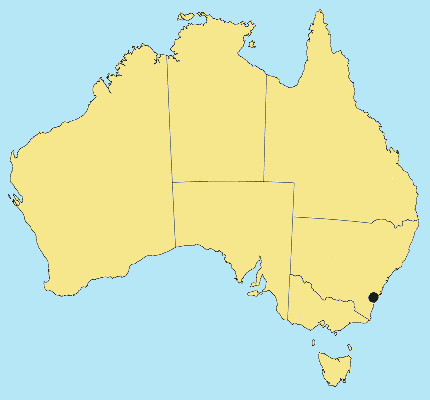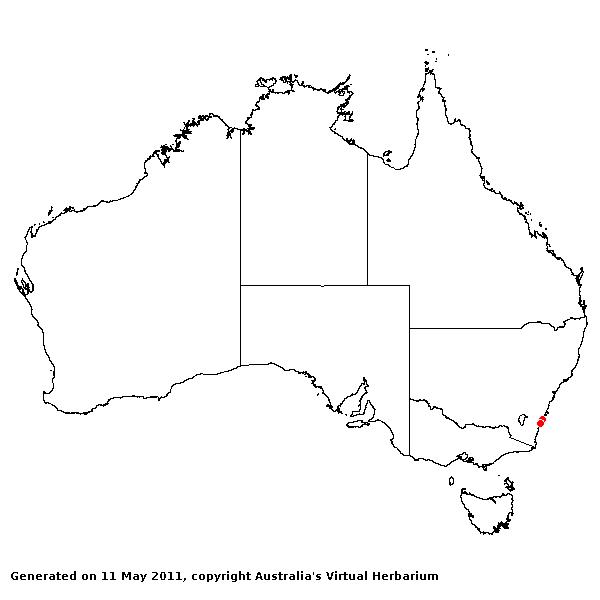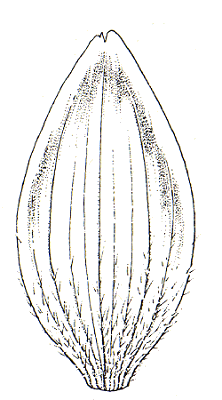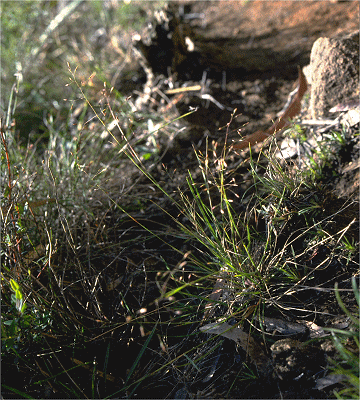Plinthanthesis rodwayi (C.E. Hubbard) S. T.
Blake. Contr. Qd Herb. 14: 3 (1972).
Classification. (GPWG 2001) : Subfamily
Danthonioideae. Tribe Danthonieae.
Basionym and/or
Replacement Name: Danthonia
rodwayi C.E. Hubb., Hooker's Icon. Pl. 35 t.: 3439 (1943).
Type of Basionym or
Protologue Information: HT: Rodway s.n., Australia (K; IT: FAR,
NSW).
Recent synonyms:
Danthonia rodwayi.
Key references (books
and floras): [2002] D.Sharp & B.K.Simon, AusGrass, Grasses of
Australia, [2008] S.W.L.Jacobs, R.D.B.Walley & D.J.B.Wheeler, Grasses
of New South Wales (343).
Illustrations:
[2005] K.Mallet (ed.), Flora of Australia 44B: Poaceae 3 (Fig. 5,
H), [2008] S.W.L.Jacobs, R.D.B.Whalley & D.J.B.Wheeler, Grasses of New
South Wales, 4th edn (343).
Habit.
Perennial. Culms decumbent, 20–60 cm tall, 2–3 -noded. Leaves mostly basal.
Ligule a fringe of hairs. Leaf-blades curled, filiform, involute or convolute,
10–20 cm long, 1–2 mm wide.
Inflorescence.
Inflorescence compound, a panicle. Panicle ovate, 4–8 cm long, 4–6 cm wide.
Spikelets.
Spikelets pedicelled. Fertile spikelets many flowered, with at least 2 fertile
florets (2–3), comprising 2–3 fertile floret(s), without rachilla extension or
with a barren rachilla extension (when 2-fld), oblong, laterally compressed,
4.5–6.5 mm long.
Glumes. Glumes
similar. Lower glume lanceolate, chartaceous, keeled, 1-keeled, 1–3 -nerved.
Upper glume lanceolate, 4.5–6.5 mm long, chartaceous, keeled, 1-keeled, 1–3
-nerved. Upper glume surface asperulous.
Florets.
Fertile lemma 2–4 mm long, without keel, 9 -nerved. Lemma surface indumented.
Lemma apex dentate, muticous or mucronate. Median (principal) awn 0.5–1.5 mm
long overall. Palea 2 -nerved. Lodicules present. Anthers 3. Grain 1.4–1.5 mm
long.
Continental
Distribution: Australasia.
Australian
Distribution: New South Wales.
New South Wales:
Southern Tablelands.
Notes.
P. rodwayi is close to P. paradoxa, and differs by the lemma awn being
either completely lost, or if still present, then straight, and by the expanded
leaf-blades. Although there is a strong superficial similarity between the two
taxa, no intermediate specimens have been found, and they do not co-occur.
Restricted
to the Mt Budawang in New South Wales., altitude 1100 m, Grassy heathland,
local usually within shrubs of Banksia or Leptospermum growing to
a height of 0.5–1 m, rarely in the open, apparently very heavily grazed, also
along access track. Flowers Dec. or Jan.




